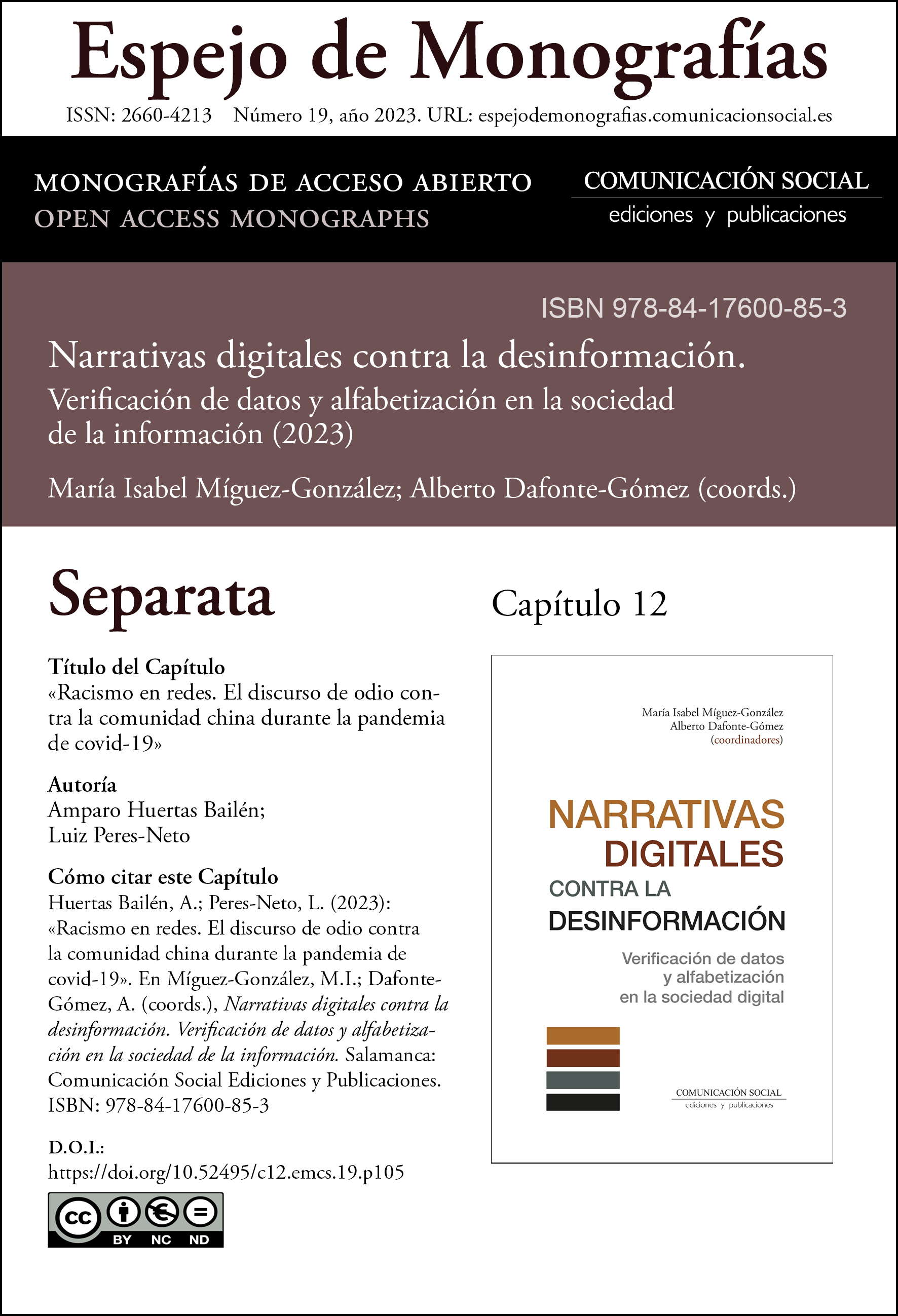Capítulo 12. Racismo en redes. El discurso de odio contra la comunidad china durante la pandemia de la covid-19
DOI:
https://doi.org/10.52495/c12.emcs.19.p105Palabras clave:
Racismo, migración, sinofobia, redes sociales, discurso de odio, covid-19Resumen
La pandemia de la covid-19, declarada el 11 de marzo de 2020 por la Organización Mundial de la Salud (OMS), no sólo fue una crisis sanitaria, sino que también desencadenó una oleada racista contra la comunidad china al ser señalada como responsable de la aparición del virus. La OMS prohibió la asociación del virus con un espacio geográfico concreto en junio de 2021, pero en las redes sociales ya se había expandido el discurso de odio, en gran parte por el comportamiento de determinados políticos y la puesta en marcha de bots. Nuestro trabajo de campo, realizado sobre una muestra de 20 personas de origen chino (migrantes, descendientes y estudiantes universitarios) residentes en el área metropolitana de Barcelona, nos permitió identificar que esta comunidad está muy acostumbrada a evitar situaciones que puedan provocar reacciones racistas. En relación al discurso de odio en línea, su presencia provoca normalmente el abandono de la actividad en redes. La juventud, por su mayor actividad digital, es la que tiene más posibilidades de sufrir estos ataques. Además, el trabajo de campo volvió a revelarnos la dificultad de abordar el racismo desde la mirada de las personas afectadas, pues acostumbran a minimizar las agresiones recibidas.
Descargas
Citas
Abidin C.; Zeng J. (2020): «Feeling Asian together: Coping with #covidracism on Subtle Asian Traits», Social Media+ Society, vol. 6, núm. 3, pp. 1-5.
Awan I.; Zempi I. (2016): «The affinity between online and offline anti-Muslim hate crime: Dynamics and impacts», Aggression and Violent Behavior, vol. 27, pp. 1-8.
Bliuc A. M.; Faulkner N.; Jakubowicz A.; McGarty C. (2018): «Online networks of racial hate: A systematic review of 10 years of research on cyber-racism», Computers in Human Behavior, vol. 87, pp. 75-86.
Bonilla-Silva, Eduardo (2020): «Color-blind racism in pandemic times», Sociology of Race and Ethnicity, vol. 8, núm. 3, pp. 343-354.
Canalda Moreno, N.; Vargas Herreño, A. (2022): This coronavirus shit is real: Racialized people, vulnerability and intersectional care in virtual social networks during the pandemic. En Olivieri, C.; Serrano-Muñoz, J. (eds.). East Asia, Latin America and the decolonization of transpacific studies. Historical and cultural interconnections between Latin America and Asia. Palgrave Macmillan Cham.
Chant, C.; Montt Strabucchi, M. (2021): «Many-faced orientalism: racism and xenophobia in a time of the novel coronavirus in Chile», Asian Ethnicity, vol. 22, núm. 2, pp. 374-394
Costigan, C.L.; Hua, J.M.; Su, T.F. (2010): «Living up to expectations: The strengths and challenges experienced by Chinese Canadian students», Canadian Journal of School Psychology, vol. 25, núm. 3, pp. 223-245.
Dhanani L. Y.; Franz B. (2021): «Why public health framing matters: An experimental study of the effects of COVID-19 framing on prejudice and xenophobia in the United States», Social Science & Medicine, vol. 269, Article 113572.
Dubey A.D. (2020): «The resurgence of cyber racism during the COVID-19 pandemic and its aftereffects: Analysis of sentiments and emotions in tweets», JMIR Public Health and Surveillance, vol. 6, núm. 4, Article e19833.
França. T.; Gaspar, S.; Mathias, D., (2022): «’It is not Good, but it could be worse’: racial microagressions toward Chinese international students during the COVID-19 pandemic», Diaspora, Indigenous, and Minority Education.
Gao, G.; Sai, L. (2021): «Opposing the toxic apartheid: The painted veil of the COVID.-19 pandemic, race and racism», Gender Work Organ, vol. 28 (S1), pp. 183-189.
Gover A. R.; Harper S. B.; Langton L. (2020): «Anti-Asian hate crime during the COVID-19 pandemic: Exploring the reproduction of inequality», American Journal of Criminal Justice, vol. 45, núm. 4, pp. 647–667.
Guardian, The (2020): «Donald Trump calls Covid-19 ‘kung-flu’ at Tulsa rally», The Guardian. https://www.theguardian.com/us-news/2020/jun/20/trump-covid-19-kung-flu-racist-language [Disponible: 1 de marzo del 2023]
Ha, S.K.; Nguyen, A.T.; Sales, C.; Chang, R.S.; Ta, H.; Srinivasan, M.; Chug, S.; Palaniappan, L.; Lin, B. (2020): «Increased self-reported discrimination and concern for physical assault due to the COVID-19 pandemic in Chinese, Vietnamese, Korean, Japanese, and Filipino Americans», Journal of Asian Health, vol. 1, núm. 1, Article 1.
Horton, R. (2020): «Offline: COVID-19 and the dangers of Sinophobia», The Lancet, vol. 396, núm. 10245, p. 154.
Human Rights Watch (2020): «El COVID-19 aumenta la xenofobia y el racismo contra los asiáticos en todo el mundo» https://www.hrw.org/es/news/2020/05/12/el-covid-19-aumenta-la-xenofobia-y-el-racismo-contra-los-asiaticos-en-todo-el-mundo
Kim, J.O. (2020): «Radical times, continuities in struggle», American Studies, vol. 59, núm. 2, pp. 39-41.
Kim J. Y.; Kesari A. (2021): «Misinformation and hate speech: The case of Anti-Asian hate speech during the COVID-19 pandemic», Journal of Online Trust and Safety, vol. , núm. 1.
Kuo R.; Zhang A.; Shaw V.; Wang C. (2020): «#FeministAntibodies: Asian American media in the time of coronavirus», Social Media+ Society, vol. 6, núm. 4, pp. 1-11.
Li, Y.; Nicholson, H.L. Jr (2021): «When ‘model minorities’ become ‘yellow peril’ –othering and the racialization of Asian Americans in the Covid-19 pandemic», Sociology Compass, vol. 15, núm. 2, e12849.kk
Litam, A. (2020): «‘Take your kung-flu back to Wuhan’: Counseling Asians, Asian Americans, and Pacific Islandes with Race-Based Trauma Related to Covid-19», The Professional Counselor, vol. 10, núm. 2, pp. 144-156.
MacAvaney S.; Yao H. R.; Yang E.; Russell K.; Goharian N.; Frieder O. (2019): «Hate speech detection: Challenges and solutions», PLoS ONE, vol. 14, núm. 8, Article e0221152.
Mamuji, A.A.; Lee, Ch.; Rozdilsky, J.; D’Souza, J.; Chu, T. (2021): «Anti-chinese stigma in the grater Toronto Area during COVID-19: Aiming the spotlight towards community capacity», Social Sciences & Humanities Open, vol. 4, núm. 1, 100232
Reichelmann A.; Hawdon J.; Costello M.; Ryan J.; Blaya C.; Llorent V.; Oksanen A.; Räsänen P.; Zych I. (2021): «Hate knows no boundaries: Online hate in six nations», Deviant Behavior, vol. 42, núm. 9, 1100-1111.
Reny T.T.; Barreto M.A. (2022): «Xenophobia in the time of pandemic: Othering, anti-Asian attitudes, and COVID-19», Politics, Groups, and Identities, vol. 10, núm. 2, pp. 209-232.
Roberto, K.J.; Johnson, A.F.; Rauhaus, B.M. (2020): «Stigmatization and prejudice during the Covid-19 pandemic», Administrative Theory & Praxis, vol. 42, núm. 3, pp. 364-378.
Stechemesser A., Wenz L., Levermann A. (2020): «Corona crisis fuels racially profiled hate in social media networks», EClinicalMedicine, vol. 23, Article 100372.
Sue, D.W; Bucceri, J.; Lin, A.I.; Nadal, K.L.; Torino, G.C. (2007): «Racial microaggressions and the Asian American experience», Cultural Diversity & Ethnic Minority Psychology, vol. 13, núm., 1, pp. 72-81.
UN. (2020). United Nations Guidance Note on Addressing and Countering COVID-19 related Hate Speech. https://www.un.org/en/genocideprevention/documents/Guidance%20on%20COVID-19%20related%20Hate%20Speech.pdf
Uyheng, J.; Bellutta, D.; Carley, K. M. (2022): «Bots Amplify and Redirect Hate Speech in Online Discourse About Racism During the COVID-19 Pandemic», Social Media + Society, vol. 8, núm. 3 pp. 1-14.
Waldron, J. (2012). The Harm in Hate Speech. Londres: Harvard University Press.
Weber M.; Viehmann C.; Ziegele M.; Schemer C. (2020): «Online hate does not stay online: How implicit and explicit attitudes mediate the effect of civil negativity and hate in user comments on prosocial behavior», Computers in Human Behavior, vol. 104, Article 106192.
Whitworth, J. (2020): «Covid-19: a fast evolving pandemic», Trans R.Soc.Trop.Med.Hyg, vol. 114, núm. 4, pp. 241-248.
Yeh, D. (2014): «Contesting the ‘model minority’: Racialization, youth culture and ‘Britihs Chinese’/’Oriental’ nights», Ethnic and Racial Studies, vol. 37, núm. 7, pp. 1197-1210.

Publicado
Cómo citar
Número
Sección
Licencia

Esta obra está bajo una licencia internacional Creative Commons Atribución-NoComercial 4.0.
Los artículos publicados en la revista se distribuyen con la Licencia Creative Commons Atribución-NoComercial-SinDerivadas 4.0 Internacional










